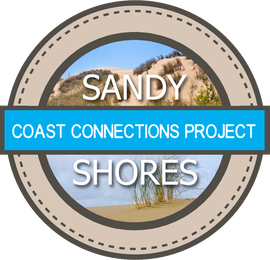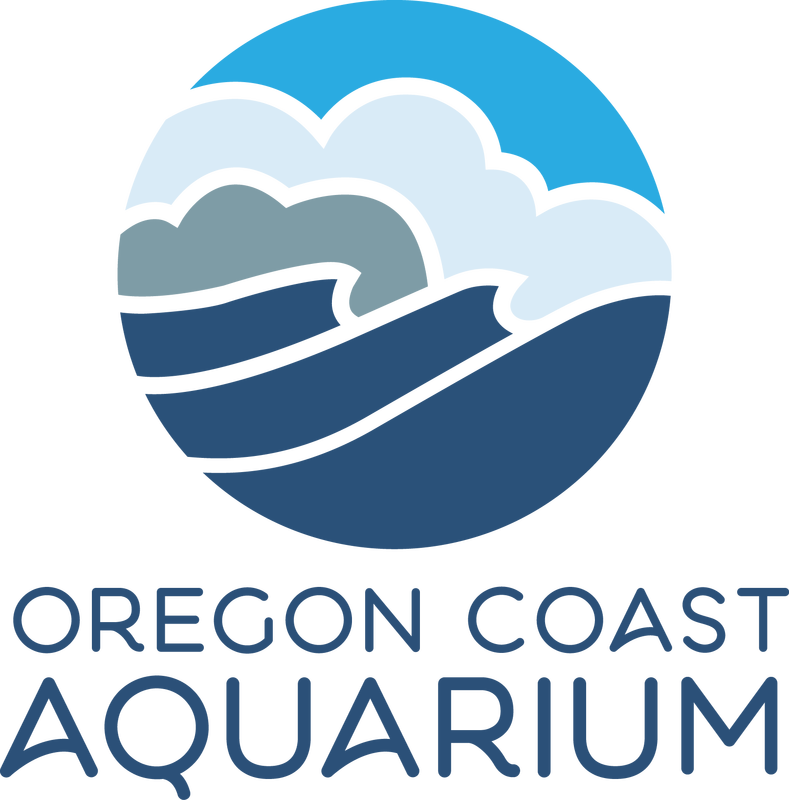
ECOSYSTEMS > OREGON COAST > DUNES
Every year, from roughly March to September, western snowy plovers nest along the Pacific Coast of North America. Historically they have used the sandy areas of beaches, bays, estuaries, and riparian areas to scratch out shallow nests and lay on average three speckled eggs. In the Oregon Dunes National Recreation Area, these tiny birds nest exclusively in the dry sand areas around the foredunes where it’s not uncommon to stumble upon one of many signs cautioning visitors about their presence.
Once widely distributed from Washington to Baja California, only about 2,000 individuals still survive in these areas, the unintentional victims of efforts to improve the coastline for human habitation.
Every year, from roughly March to September, western snowy plovers nest along the Pacific Coast of North America. Historically they have used the sandy areas of beaches, bays, estuaries, and riparian areas to scratch out shallow nests and lay on average three speckled eggs. In the Oregon Dunes National Recreation Area, these tiny birds nest exclusively in the dry sand areas around the foredunes where it’s not uncommon to stumble upon one of many signs cautioning visitors about their presence.
Once widely distributed from Washington to Baja California, only about 2,000 individuals still survive in these areas, the unintentional victims of efforts to improve the coastline for human habitation.
The Problem with Blowing Sand...
“Early settlers along the Oregon Coast saw blowing sand as a problem,” said Cindy Burns, a biologist with the U.S. Forest Service who oversees much of the plover’s recovery on the Oregon Dunes. “The blowing sand was covering up roadways, driveways, homes and whatnot. People needed to figure out a way to stop the blowing sand and came up with planting European beach grass.”
Because this grass was not native to Oregon, it had no natural controls to limit its spread and often took over space once used to local plants and animals. Today, beach grasses (both European and American varieties) are only two of many invasive plant species damaging the Oregon Dunes.
“The beach grass was so effective it took over much of the sandy coastline and swallowed up a lot of the plover’s nesting sites,” said Cindy.
The plover’s plight was further complicated by other human-caused factors. The development of towns and cities, often located in the same areas where the bird nested, further reduced its numbers. Increasing tourism to the Oregon Dunes meant an increase in nesting areas being disturbed or destroyed. Natural forces, such as predation and spring storms, also take their toll on the bird’s numbers.
“The plovers nest on the open sand and their eggs are about the size of the end of my thumb and are speckled to look like sand,” said Cindy. “It’s very easy to step on them and not even realize it.”
Today, the plover’s nesting areas are less than a third of what they were prior to the introduction of beach grasses and widespread development of the coast. It is because of their small numbers that they are designated as a Threatened Species under the U.S. Endangered Species Act and by the Oregon Fish and Wildlife Commission. These designations mean the bird has extra protections under the law and the Forest Service has implemented a variety of rules and strategies to help with its recovery.
Because this grass was not native to Oregon, it had no natural controls to limit its spread and often took over space once used to local plants and animals. Today, beach grasses (both European and American varieties) are only two of many invasive plant species damaging the Oregon Dunes.
“The beach grass was so effective it took over much of the sandy coastline and swallowed up a lot of the plover’s nesting sites,” said Cindy.
The plover’s plight was further complicated by other human-caused factors. The development of towns and cities, often located in the same areas where the bird nested, further reduced its numbers. Increasing tourism to the Oregon Dunes meant an increase in nesting areas being disturbed or destroyed. Natural forces, such as predation and spring storms, also take their toll on the bird’s numbers.
“The plovers nest on the open sand and their eggs are about the size of the end of my thumb and are speckled to look like sand,” said Cindy. “It’s very easy to step on them and not even realize it.”
Today, the plover’s nesting areas are less than a third of what they were prior to the introduction of beach grasses and widespread development of the coast. It is because of their small numbers that they are designated as a Threatened Species under the U.S. Endangered Species Act and by the Oregon Fish and Wildlife Commission. These designations mean the bird has extra protections under the law and the Forest Service has implemented a variety of rules and strategies to help with its recovery.

INVASIVE PLANTS OF THE OREGON DUNES:
Can a species be “unfriendly?” Ecologically speaking, yes. Invasive species (plants and animals which are introduced to an area where they are not native and whose introduction is likely to cause harm), can cause enormous damage to ecosystems, agriculture, and even human health. Listed below are the most prevalent invasive plants in the Oregon Dunes. Click on a species to learn more about it. American beach grass | European beach grass | Gorse weed | Scotch broom |
A Story of Success
During nesting season, plover monitors are employed to assess how many young are hatching, to tag new birds, and to help keep tourists away from sensitive beach areas. Additionally, there are prohibitions on both motorized and non-motorized vehicles on the beaches. Even kites and drones — which cause plovers to abandon their nests when they mistake them for predatory birds and cause them to abandon their nests — are not allowed.
However, these efforts will mean little if the plover’s nesting area is not expanded. In 2015, the Forest Service began a longterm approach to help not only the plover, but also the larger dune ecosystem and the native plants and animals that inhabit it.
However, these efforts will mean little if the plover’s nesting area is not expanded. In 2015, the Forest Service began a longterm approach to help not only the plover, but also the larger dune ecosystem and the native plants and animals that inhabit it.

Endangered Oregon: The Snowy Plover Success Story. The story of the western snowy plover is an inspiring one. In this video, US Forest Service biologist Cindy Burns discusses how human intervention in the Oregon dunes and along the coast accidentally caused the decline of the bird — and how modern intervention is being applied to correct past mistakes.
“The eradication of invasive plants like European beach grass is very important if the dunes are to ever return to their original state, which in turn will help wildlife like the snowy plover,” said Lisa Romano, Public Affairs Staff Officer for the Forest Service.
The Forest Service is employing heavy machinery like bulldozers and backhoes because invasive plants spread rapidly and often have deep root systems which are impervious to herbicides or hand-pulling. The beach grasses, for example, have continuously growing underground stems called rhizomes which allow them to spread over a vast area.
“If we leave any of the rhizomes behind, the grass will come right back,” explained Lisa. “In some of the dunes, the rhizomes may be as deep as thirty feet beneath the surface. The only way to get them out is to pull the dune apart with bulldozers and then recreate the dune after the plant’s completely removed.”
It is impossible to remove invasive plants from the entirety of the Oregon Dunes, so the Forest Service and its partners are targeting select areas which will provide the greatest benefit to native species, including the plover. While it may seem like an insurmountable task, the Forest Service has seen a steady increase in snowy plover populations since their efforts began.
To further assist with the restoration of the dunes and the recovery of the plover, the Oregon Dunes Restoration Collaborative was established in 2015. This organization helps to raise public awareness and organize volunteers and citizen science projects to aid in recovery efforts. More information about the collaborative’s work can be found at SaveOregonDunes.org.
The Forest Service is employing heavy machinery like bulldozers and backhoes because invasive plants spread rapidly and often have deep root systems which are impervious to herbicides or hand-pulling. The beach grasses, for example, have continuously growing underground stems called rhizomes which allow them to spread over a vast area.
“If we leave any of the rhizomes behind, the grass will come right back,” explained Lisa. “In some of the dunes, the rhizomes may be as deep as thirty feet beneath the surface. The only way to get them out is to pull the dune apart with bulldozers and then recreate the dune after the plant’s completely removed.”
It is impossible to remove invasive plants from the entirety of the Oregon Dunes, so the Forest Service and its partners are targeting select areas which will provide the greatest benefit to native species, including the plover. While it may seem like an insurmountable task, the Forest Service has seen a steady increase in snowy plover populations since their efforts began.
To further assist with the restoration of the dunes and the recovery of the plover, the Oregon Dunes Restoration Collaborative was established in 2015. This organization helps to raise public awareness and organize volunteers and citizen science projects to aid in recovery efforts. More information about the collaborative’s work can be found at SaveOregonDunes.org.
Related Features:
Floras Lake State Park: This little known lake on South Oregon Coast is a sanctuary containing diverse ecosystems like coastal forests, meadows, beaches and riparian areas.
Formation and Destruction of a Dune Sea: It's taken tens of thousands of years for Oregon amazing coastal dunes to form, but the recent introduction of a few plants has dramatically changed this ancient landscape in just a few decades.
Hiking the John Dellenback Dunes Trail: Explore this picturesque trail which snakes through a variety of coastal ecosystems including a conifer forest, riparian areas and a dune sea.
Landmark Place: Oregon Dunes National Recreation Area: This national recreation area helps visitors explore and understand one of the largest swaths of coastal dunes on the planet.
On a Mission to Save A Butterfly: A group of teens from Pennsylvania travel to Oregon on a mission to help save a critically endangered butterfly.
Saving the Silverspot: Youth volunteers from all over Oregon come to the aid of the tiniest of creatures, the Oregon silverspot butterfly. See how these stewards help recreate missing habitat so the insect has a better shot at survival.
Formation and Destruction of a Dune Sea: It's taken tens of thousands of years for Oregon amazing coastal dunes to form, but the recent introduction of a few plants has dramatically changed this ancient landscape in just a few decades.
Hiking the John Dellenback Dunes Trail: Explore this picturesque trail which snakes through a variety of coastal ecosystems including a conifer forest, riparian areas and a dune sea.
Landmark Place: Oregon Dunes National Recreation Area: This national recreation area helps visitors explore and understand one of the largest swaths of coastal dunes on the planet.
On a Mission to Save A Butterfly: A group of teens from Pennsylvania travel to Oregon on a mission to help save a critically endangered butterfly.
Saving the Silverspot: Youth volunteers from all over Oregon come to the aid of the tiniest of creatures, the Oregon silverspot butterfly. See how these stewards help recreate missing habitat so the insect has a better shot at survival.




